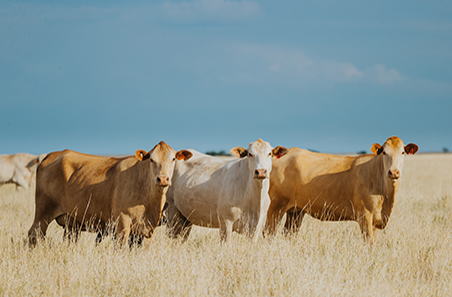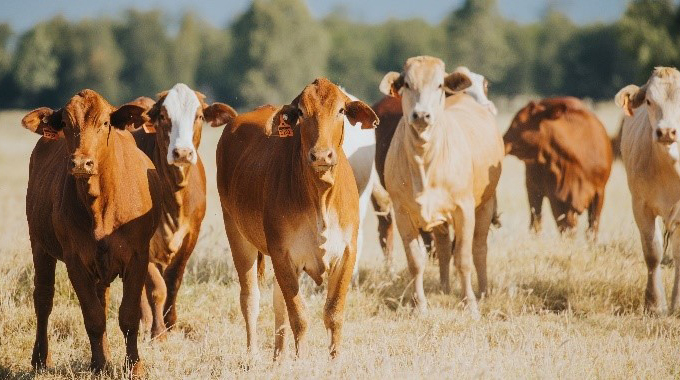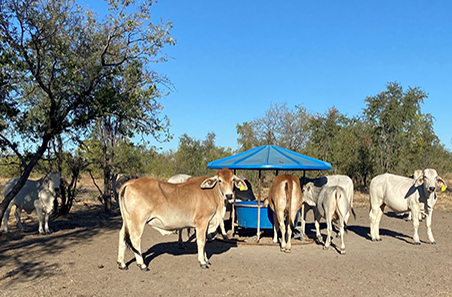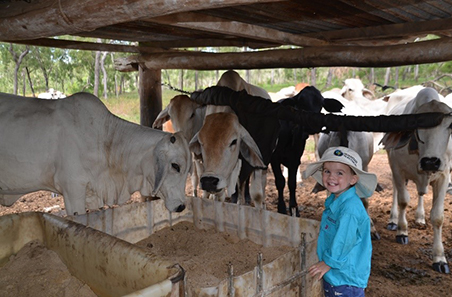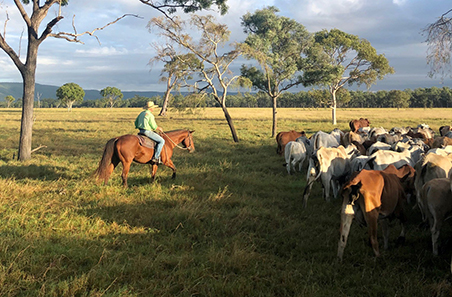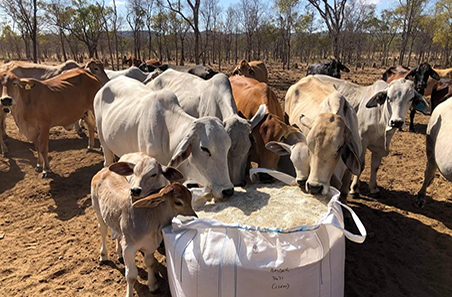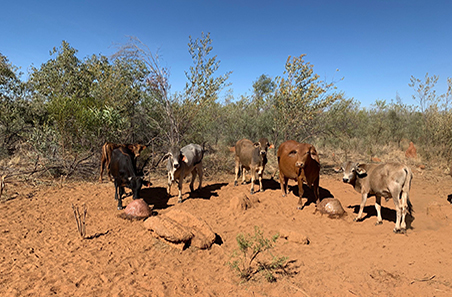
Phosphorus deficiency
Phosphorus deficiency in cattle causes significant production and economic losses in beef enterprises across northern Australia. This P hub aims to support beef producers to identify where a deficiency is a problem and how to remedy the issue through implementation of an effective P supplementation program.
This resource hub covers:
MLA recently released an updated P manual – Phosphorus management of beef cattle in northern Australia (second edition) – which offers evidence-based solutions and recommendations on how to assess and address the risk of P deficiency in cattle.
Where land types have deficient soils, effective P supplementation delivers significant productivity and profitability benefits for beef businesses.
A dietary P deficiency results in lower growth and reproduction rates even when the energy and protein content of the diet are adequate. This is particularly relevant for weaners and cattle during late-pregnancy or lactation due to the higher demands of growth and milk production.
Supplementing on acutely P-deficient soils is profitable and best results are observed in conjunction with best-practice herd and grazing land management. Feeding P in the wet (growing) season gives the greatest economic benefit on P-deficient country.
In P-deficient areas, supplementing breeding and growing herds with P provides a return on investment within one to four years, depending on stock class and the severity of the deficiency.
Effective P supplementation improves beef enterprise profitability through:
- cattle sold earlier and/or at heavier weights
- increased body condition score of breeders
- increased milk production, weaner weights and pregnancy rates
- a higher proportion of heifers attaining critical mating weights and at a younger age
- cow weights up to 100kg/head heavier
- reduced mortality rates.
If P is fed over the wet season on deficient country:
- young growing stock can increase their growth by up to 90kg above base growth
- breeders can increase weaning rates by 10–30%
- mature breeders can maintain an additional 100kg weight advantage over un-supplemented cows.
A marginal P deficiency is common and difficult to diagnose. Overall herd productivity, including growth rates, breeder condition, weaning rates and weights will be lower than expected. Shortage of feed due to heavy stocking rates or dry years, low energy and protein in the pasture and diet, weaning management, disease or another nutrient deficiency, can also be factors that contribute to poor productivity.
Herd management issues need to be addressed to achieve the best results from P supplementation. Be realistic about land condition and the number of animals the property can support. No supplementation program can replace good pasture and herd management.
If an acute deficiency is observed, breeders show lameness and tenderness walking to the yards. Depraved appetite leading to pica (eating things of no nutritional value) such as bones, stones, polythene pipe or horns is also an indicator of P deficiency. A protein deficiency in the diet can also induce pica.
Clinical signs of P deficiency include peg-leg (arched body, staggering gait and brittle bones), especially in drier years. Broken bones can occur when working the cattle in yards. These clinical signs are the last signs of P deficiency to appear.
If these signs are evident in a herd, then there will be significant losses in productivity occurring prior to reaching this stage. It is rare to observe these severe problems in modern times as awareness of P deficiency has increased across northern Australia and small amounts of P are often included in dry season licks. A P supplementation program is critical to address a P deficiency in a herd.
P - Are you on the map?
Soil plant-available P stocks are a key indicator of cattle productivity. A high-resolution map shows plant-available P across areas of Queensland. 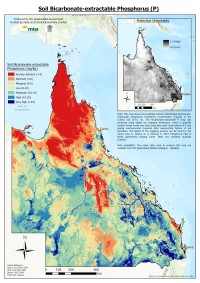
The map has been especially developed for livestock producers to easily identify areas at risk of deficiency and support more targeted and efficient phosphorus supplementation. Phase three of this map which will include the remaining northern regions will be completed by the end of 2024.
Produced by Queensland Government of Environment and Science with support from MLA, this helpful tool and supporting data is readily available online.
- Download the Phosphorus map infosheet
- View the detailed Phosphorus map (GeoPDF 15.1MB). More information about this map can be found here.
Phosphorus should be fed to all livestock grazing P-deficient land types. Feeding a P supplement in the wet season yields the greatest economic benefit on P-deficient areas. Protein content, pasture digestibility and P concentration decrease as pastures senesce in the dry season. Cattle growth rates also decline and the nutritional requirement is lower at maintenance. Cattle are not likely to show a weight gain response to supplementary P from the middle of the dry season until the next seasonal break unless there is good late rain, or a high proportion of legume in the pasture.
Typically supplements should include enough P to provide 6–10g P/day in the wet season and 2–5g P/day in the dry season.
Find out more on when to feed P by reading Chapter 4 of the Phosphorus management of beef cattle in northern Australia (second edition)
|
Once a P deficiency has been identified, getting started on a supplementation program on part or all of a property is an important decision. Supplement feeding is a significant cost for any business. One option is to start with one paddock to get the right loose mix recipes for your land types and class of cattle. Although feeding mature breeders will ultimately have the biggest flow-on effect by increasing body condition. Increased body condition has many positive effects including:
First-calf cows or growing steers will show a quicker growth response compared to mature cows. First-calf cows have a higher requirement for P due to the fact they are still growing as well as growing a foetus and then lactating, and as such are a priority for P supplementation. |
Did you know? Cattle grazing deficient pastures and fed an effective P supplement will eat 10–30% more pasture (deficient cattle have a depressed intake). |
|
Once a P deficiency has been identified, getting started on a supplementation program on part or all of a property is an important decision. Supplement feeding is a significant cost for any business. One option is to start with one paddock to get the right loose mix recipes for your land types and class of cattle. Although feeding mature breeders will ultimately have the biggest flow-on effect by increasing body condition. Increased body condition has many positive effects including:
First-calf cows or growing steers will show a quicker growth response compared to mature cows. First-calf cows have a higher requirement for P due to the fact they are still growing as well as growing a foetus and then lactating, and as such are a priority for P supplementation. |
|
Did you know? Cattle grazing deficient pastures and fed an effective P supplement will eat 10–30% more pasture (deficient cattle have a depressed intake). |
- Choose a supplement that ensures adequate consumption of P irrespective of whether it is the source fed alone or mixed into a supplement during the wet season.
- Compare P supplement options that will be consumed during the wet season on a cost per unit of P basis.
- Use only high quality P sources to ensure that P is readily available and scant in both heavy metals and fluorine.
- Supplement blocks and loose licks each have merits – to attain production goals, cattle must eat it. Monitor intakes and adjust recipe when required to avoid wasting money on supplement that sits in the paddock.
- On deficient pastures, wet season supplement intakes should aim to provide at least 6g P/head/ day to young growing cattle and 10g P/head/day to breeders.
- Dry season supplement mixes should contain a source of protein (e.g. urea) with sufficient P content to provide 2–5g P per day per animal.
- The economic benefits from feeding P are maximised when done in conjunction with other aspects of good herd management. Order P supplement and make realistic calculations for how much P you need to last the entire wet season.
- Choose a supplement that ensures adequate consumption of P irrespective of whether it is the source fed alone or mixed into a supplement during the wet season.
- Compare P supplement options that will be consumed during the wet season on a cost per unit of P basis.
- Use only high quality P sources to ensure that P is readily available and scant in both heavy metals and fluorine.
- Supplement blocks and loose licks each have merits – to attain production goals, cattle must eat it. Monitor intakes and adjust recipe when required to avoid wasting money on supplement that sits in the paddock.
- On deficient pastures, wet season supplement intakes should aim to provide at least 6g P/head/ day to young growing cattle and 10g P/head/day to breeders.
- Dry season supplement mixes should contain a source of protein (e.g. urea) with sufficient P content to provide 2–5g P per day per animal.
- The economic benefits from feeding P are maximised when done in conjunction with other aspects of good herd management. Order P supplement and make realistic calculations for how much P you need to last the entire wet season.
To work out how much P cattle have consumed, download the Calculating supplement intakes and costs calculator.
Find out more on starting a P supplementation program by reading Chapter 5 of the Phosphorus management of beef cattle in northern Australia (second edition)
 Learn more through The Toolbox online training: Why do cattle need phosphorus?
Learn more through The Toolbox online training: Why do cattle need phosphorus?
This module is designed as a guide for northern beef producers. It outlines why phosphorus is important, what the research has revealed about phosphorus supplementation, how to identify a phosphorus deficiency in your herd and how to supplement for P-deficient beef herds.
Resources
- Future Beef's webinar P is for profit and for phosphorus – and that’s not all the two have in common!
- Future Beef’s webinar Phosphorus supplementation for improved productivity and profitability of beef businesses – Part 1
- Future Beef’s webinar Phosphorus supplementation for improved productivity and profitability of beef businesses – Part 2
- Future Beef’s Improving beef business performance with phosphorus supplementation



